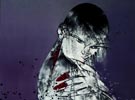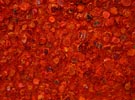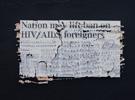Variations: Origin and Return
Since 2002, Luo Xu and his art, which used to be appreciated only by Kunming art community and subcultures, started to arouse the interest of a broader audience. In 2000, Ye Yongqing curated the first solo exhibition of Luo Xu after he started building the Aboriginal Nest. The exhibition “The Vain Hopes and Bizarre Ways” presented a collection of works created during the 4 years that he spent in the Nest. Thanks to this solo exhibition, the relatively unbiased artists and critics started to notice and include Luo Xu into the large context of Chinese contemporary art, either willingly or unwillingly. Yet as mentioned above, Luo Xu closely links art with his life and bodily senses. That is, he ploughs his art in the Aboriginal Nest and the peripheries located in the remote area of Kunming, Yunnan. In contrast, Chinese contemporary art undoubtedly sets itself in a “public space”. Therefore, as the artist participates in a wider range of activities, controversy and misreading arise. The media and the public, catering to their own needs, identify him as a hermit, a genius, or even a local specialty of Yunnan. Only focusing on what they desire, they rarely pay attention to the actual artworks.
It is during this period that Luo started to establish female thigh as the dominating motif. The motif continued from the Eastern Venus series to the Variation series. Further discussions also appear in his later works and images. The process and the result of this artist attempt are still under debate, but it seems to be rooted in the attempt the huge discomfort he felt towards the definition he is given in contemporary art. He argues against the definition and responses to the peculiar gazes in a direct mirror-like way. He never disguises his lack of passion for contemporary art and indeed ridicules it.
The artist further developed the selected elements from the Nest Period. Early works such as The Versatile Bag and 99th Flood Peak presented the epic legs. Now these legs become blades and spears, poking at almost everything. After escaping from the darkness of the Nest, the bodies, exposed in daylight, now represent bare desire. Thereafter, just like the desire of our time, they have encountered numerous variations. With the possibilities, Luo has conducted a series of wild experiments on both the form and the material. Nonetheless, the strong awareness of the form and the bodily senses prevents his work from being completely conceptualized. In fact, he pulls his work back to the sensational and emotional swirl when it reaches the boundaries of conceptualization.
Working within this “swirl”, Luo starts out with flesh bodies and returns to individuals. In a series of works, he ostentatiously displayed the luxury, the extravagance and the desire of our times. Rather than disparaging the desire, the artist is indeed celebrating it. As if we were drunk, in the end, we wake up facing our own vomit. Although we might not reach an epiphany, the momentary shame and loss of mind gradually creeps into the camouflage justification we build for our time and our own desires, leaving unavoidable traces and marks.
At this point, Luo is not only fond of a vibrant palette, but also becomes bolder with the material. On the one hand, clay and plaster used for early works lack the expressiveness needed to represent the grotesque desire. On the other hand, entering his fifties, the artist has achieved full control over various materials and artisanship. As long as a piece fully conveys the idea, he is not against putting it into a mundane system. Crawling before the steel legs certainly expresses self-satire. Yet it is no longer necessary or possible to bring back the holiness and enchantment of The Choir and Prayer at Dawn.
After spending years on this constant obsession with desire, Luo puts an end to the topic. He then immerses himself into the tranquility of the series Bronze Leaves. The destructible will eventually decay, such as food and sex; and, the latter is just like the life of the leaves, natural and touching.
An Empty Shell: Interference and Departure
By observing his art career, we find the common trait of artists who concentrate more on forms rather than ideas: that is, more often the transfiguration of forms drives forward the artistic creation while ideas follow afterwards or remain absent. This is how Luo extracts the thighs from the poetic and closed setting of the Aboriginal Nest. After variations, the same topic meets the leaf of life. Finally, inspired by calligraphy, he develops these forms into tadpoles.
Various factors contributed to the Tadpole Series. The first visual information might have originated from the gentle rain during the wet season in 2010. Yet if we look for the self-explanatory hints hidden in the form of his works instead of marrying his art to random emotions, we definitely will not miss the evidence revealed by his later planar works such as the Variation series. Works such as the oil paintings Atypical Insects have provided enough information for us to confirm that the form comes first, and then follows the idea.
In the collection that Luo started in 2010, he proposed a vision of the origin through a series of paintings and sculptures. He states:” I am one of the tadpoles.” The tadpoles crowd the paintings, both in their representational and abstract forms. In City Tadpoles and The Delivery Room, the artist makes use of different amount of steel, diversified compositions and light effects to express his ideas. Nevertheless, he jubilantly devotes himself to this vision and fervently invites the viewers to join him. When the changing laser beam projects the tadpoles, or sperms, onto the exhibition space and the viewers, they miss no one. No matter who you are and what you are, you are merely one of the millions who rush towards reincarnation. Besides, we have no idea what each of them will grow into, a frog, a toad or a salamander. We struggle in this initial state of life, and honestly have no idea what we are. Are we men, are we ghosts? It might be the case that when one places himself in the scene, rich or poor, handsome or modest, he eventually realizes that he is no more than just a tadpole.
Luo paradoxically presents a sophisticated but simple metaphor. Surrounded by the swimming tadpoles, neither a city nor a person can escape the interlaced network of individuals. Here, a blind but frantic power lingers between sanity and insanity, manipulating interest, human and incidence. The taker of this action is, once again, desire.
It is desire that drives us to engage; it is also desire that calls us to retreat. While the former still holds a touch of rejoice, the latter, as it appears in Soul Rend by Luo Xu, is only left with a sigh, left with nothing.
The elements in Soul Rend are extremely simple: a sumptuous dress, drawn from romantic novels, a chic trench coat and a gentleman cap. These elements, depicted in paintings or steel sculptures, either combine with each other or wander alone. They keep the manner and dignity of the owner, but the subject, what we sometimes call the person, is missing. In modern cities, it can be generalized as the body of the man with power and connections. Even if we restrain from commenting on this particular form, we are unable to decide whether he is invisible or completely gone. Is the absence of the owner tempting us to seize the power? Is it warning us that it is just an illusion?
Dominated by the unreal and mystic subject matter, the work can lead to emptiness. However, when situated in Shanghai, in China today, in our real life, it holds an unambiguous implication--power and connections, together with knowledge and desire, are trying to corrupt every individual, and eventually destroy him. Just as presented in the work, the ghost-like desire is searching every corner to find the possible host, and then eats him up and completely wipes him out.
With his fierce fighting tadpoles, with the empty but luxurious dresses that still bear the scent of the owner, Luo Xu breaks down our hypocritical disguise and forces every one of us to confront him directly.
Written in Beijing, Sept.16, 2011




